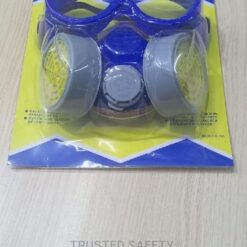Express Deliveries country wide.
dust mask

This dust mask, also known as a particulate respirator or a filtering facepiece respirator, is a type of personal protective equipment (PPE) designed to protect the wearer from inhaling hazardous particles or dust present in the air.
Quantity:
Continue Shopping
Category: Mask
Description
A dust mask, also known as a particulate respirator or a filtering facepiece respirator, is a type of personal protective equipment (PPE) designed to protect the wearer from inhaling hazardous particles or dust present in the air. Here are some key features and considerations of a dust mask:
Purpose: Dust masks are primarily used to filter out solid particles suspended in the air, including dust, pollen, mold spores, certain types of bacteria, and other particulate matter. They help protect the respiratory system from irritants and potential health hazards associated with airborne particles.
Filtration Efficiency: Dust masks feature a filtering material or medium that effectively traps and filters out particles of various sizes. The filtration efficiency of a mask is indicated by its assigned filtration rating, such as N95, N99, or N100, which denotes the percentage of particles it can filter out.
Construction: Dust masks typically consist of several components, including a filter media, a nose clip or adjustable metal strip for fitting the mask to the nose, elastic straps or headbands to secure the mask in place, and sometimes an exhalation valve to facilitate easier breathing and reduce heat buildup.
Fit and Seal: It is essential for a dust mask to have a proper fit and a tight seal to be effective. A good fit helps prevent unfiltered air from entering around the edges of the mask. Adjustable nose clips or metal strips can be molded to fit the shape of the nose, and elastic straps or headbands should securely hold the mask in place without causing discomfort.
Disposable or Reusable: Dust masks are available in disposable or reusable forms. Disposable masks are designed for single-use and are discarded after use, while reusable masks can be cleaned and reused multiple times, typically with the replacement of filter cartridges or filter inserts.
Comfort and Breathability: Dust masks aim to provide a balance between protection and wearer comfort. They are designed to be lightweight, breathable, and non-restrictive, allowing for ease of breathing during use. Some masks have additional features, such as foam padding or inner layers for added comfort.
Application: Dust masks are commonly used in various industries and occupations, including construction, woodworking, mining, agriculture, manufacturing, and healthcare. They are also used by individuals in environments with high levels of airborne particles, such as during cleaning, gardening, or DIY projects.
Limitations: It is important to note that dust masks are not suitable for protection against gases, vapors, or chemicals. For such hazards, other types of respirators, such as gas masks or air-purifying respirators, are required. Additionally, dust masks should not be used in oxygen-deficient or immediately dangerous to life or health (IDLH) environments.
Proper selection, fit, and usage of a dust mask are essential to ensure effective protection against airborne particles. Following manufacturer instructions, replacing masks as recommended, and adhering to occupational health and safety guidelines are important for maintaining respiratory health and safety.



